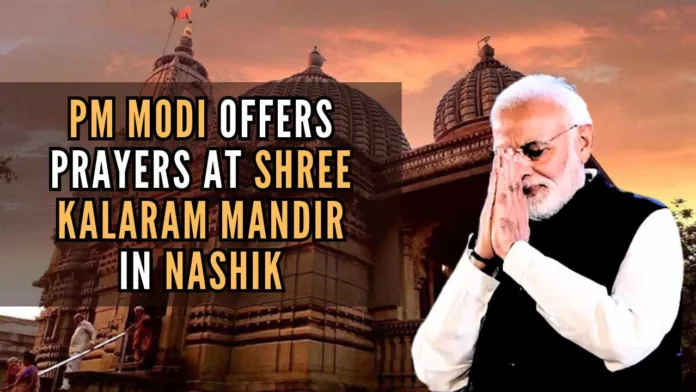
PM Modi’s spiritual cleanse: Rituals at Shree Kalaram Mandir in Nashik
Ahead of the ‘Pran Pratishtha‘ of Shri Ram Mandir in Ayodhya, Prime Minister Narendra Modi prayed at the historic Shree Kalaram Mandir in the Panchvati area of Nashik.
Prime Minister Narendra Modi started an ‘11-day special ritual‘, from today, ahead of the inauguration ceremony of the Shri Ram Mandir.
Shree Kalaram Mandir is located in the Panchavati area, where Shri Ram, Maa Sita, and Lakshman lived for over two years of their 14-year ‘vanvaas’ and the Shree Kalaram Mandir also has 14 steps, symbolizing the exile period.
The temple derives its name from a black idol of Shri Ram along with Sita and Lakshman, plus a black statue of Lord Hanuman at the main entrance of the temple.
The PM was welcomed by the trustees of the Shree Kalaram Temple Trust, then he was taken around the temple precincts, and took ‘darshan’, performed an ‘aarti’, was honoured with a shawl, and later presented with a photo frame of the temple idols, a replica of the temple and a plaque.
Later, Modi sat with some priests and bhajan singers and took part in the singing of holy hymns by playing a pair of mini-cymbals, at the temple situated in the lush green hills of Panchvati overlooking the northern banks of the river Godavari.
The Mandir’s official website informs that the present temple construction began in 1780 by Sardar Rangrao Odhekar and Sawaee Madhavrao Peshwa, and is a unique example of the architecture of that era.
While the main temple was completed in 1792, later the sabha mandap, the stilt around the temple, and fencing were also finished by 1799.
The expert masons of that period dug out blocks of the best quality black stone from the Ramshej Hills near Nashik and then tested each block in boiling milk before using it for the temple construction.
“The main structure of the temple stands in the middle of a walled enclosure with 96 pillars and an entrance on the east through an arched portal. The ‘Kalash’ is made of 32 tons of gold. The copper peak of the temple is gold-plated and looks ravishing by day and night as well,” as per the temple website.
The blackstone Shree Kalaram Mandir construction cost Rs.23 lakhs and 2,000 workers toiled on it for 12 long years to build the magnificent structure as it stands today. The copper peak of the temple is gold-plated and is all glitter during the day and night.
The temple has a more contemporary historical and social connect, when in 1930, Dr B.R. Ambedkar, the champion of the deprived masses, social reformer and the Chief Architect of the Constitution, led a huge protest here, seeking entry of Dalits.
The government now plans to make an integrated pilgrim tourist circuit for the region comprising Panchvati, Trimbakeshwar, akin to the Ayodhya-Kashi corridor.
[With Inputs from IANS]
For all the latest updates, download PGurus App.










